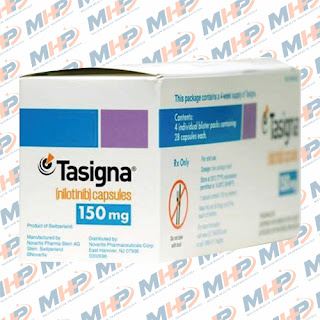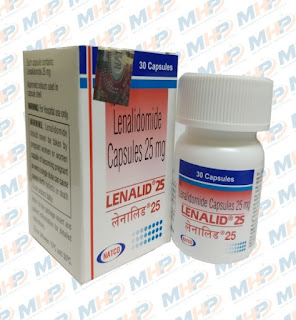TASIGNA 150mg
Drug profile of Tasigna
Tasigna capsules are categorized as an orally bioavailable aminopyrimidine derivative which is considered as Bcr-Abl tyrosine kinase prohibitor containing anti-tumor activity.
To overwhelmed Imatinib resistance, nilotinib which is an active substance of Tasigna capsules binds to and balance the inactive configuration of kinase domain of Abl protein of Bcr-Abl merging protein, concluding as prohibition of multiplication of Philadelphia chromosome positive advanced myeloid leukemia which is mediated by Bcr-Abl.
Nilotinib therapy induces the level of serum amino transferase which may leads to cause severe liver injury.
Nilotinib is pharmacologically classified as;
Anti-neoplastic agent
Bcr-Abl tyrosine protein kinase inhibitor
Imatinib resistance advanced myelogenous leukemia drug
 |
| TASIGNA 150mg |
Prescribing information of Tasigna
The prescribing information of Tasigna capsules for both pediatric and adult patients is given as follows;
Patients with newly diagnosed Philadelphia chromosome positive CML-CP; patients suffered with resistance or intolerance Philadelphia positive CML-CP & CML-AP mainly in adults; & patients with resistance or intolerance Philadelphia positive CML-CP majorly in pediatric patients.
For all these conditions, Tasigna capsules are indicated for both adults and pediatric with the age of greater than or equal to 1 year.
Tasigna is used only after resistance occurred with prior tyrosine kinase inhibitor therapy.
Mechanism of Tasigna
Tasigna containing Nilotinib is pharmacologically classified as Bcr-Abl tyrosine kinase inhibitor.
Tasigna is used to overthrown the Imatinib resistance in advanced myelogenous leukemia condition.
Nilotinib is involved in the inhibition of Bcr-Abl interceded multiplication of murine leukemia cells lines and human cell lines obtained from patients with Philadelphia positive CML.
Absorption
The mean bioavailability of Nilotinib is reaches as 50% after drug intake.
The maximum plasma concentration time of Nilotinib reaches within 3 hours after oral administration.
The effect of food with Tasigna capsules are, while comparing with fasted state the systemic exposure elevated by 82% when the dose was administered with high fat meals.
Distribution
Blood serum ratio 0.68; nilotinib is highly bound to the human plasma protein with the range of 98%.
Metabolism
The metabolism of Tasigna is mediated by CYP3A4 with minor extent by CYP2C8.
Nilotinib is the vital component circulating majorly in the blood stream; no metabolites are contributing in pharmacological action.
Excretion
Half life period: 17 hours at 69%
Creatinine clearance: 29L/hr
After single dose of Tasigna, the excretion is occurs within 7 days of administration with more than 90% range; 93% in feces. The active form of drug assumed for 69%.
When to take the Tasigna
Tasigna capsules should be administered on an empty stomach.
Food should not be take for at least 2 hours earlier the dose and for at least 1 hour after the dose.
Patients who are unable to swallow the capsules or capsules should be immersed in one teaspoon of applesauce and dissolves it and drink the solution immediately.
In some cases Tasigna should be combined with hematopoietic growth factor like erythropoietin or G-CSF or may be combine with hydroxy urea or anagrelide
Dosage regimens of Tasigna
For newly commenced ph+ CML-CP:
The prescribed dose of Tasigna is 300mg should be administered orally as two times a day.
For resistance or intolerance ph+ CML-CP or CML-AP:
The prescribed dose of Tasigna is 400mg should be administered as orally as two times day.
In pediatric:
For newly commenced or resistance ph+ CML-CP:
The prescribed dose of Tasigna for pediatrics is, 230mg/m2 should be administered orally as two times a day around 50mg dose and maximum dose should be 400mg single dose.
Depending on body surface area the dose should be considered;
Up to 0.32m2: 50mg for single dose; 100mg for total daily dose
0.33 to 0.54m2: 100mg for single dose; 200mg for total daily dose
0.55 to 0.76m2: 150mg for single dose; 300mg for daily dose
0.77 to 0.97m2: 200mg as single dose; 400mg as total daily dose
0.98 to 1.19m2: 250mg as single dose; 500mg as total daily dose
1.20 to 1.41m2: 300mg as a single dose; 600mg as total daily dose
1.42 to 1.63m2: 350mg as single dose; 700mg as total dose
> Or equal to 1.64m2: 400mg as a single dose; 800mg as total daily dose.
Interrupt or discontinue the Tasigna therapy in the patients who are having hematological toxicities.
Patient with increased serum amylase or lipase, bilirubin, AST; the therapy should be interrupt and monitor the levels.
Continue the therapy with 400mg of Tasigna as single dose.
In pediatric the dose should be 230mg/m2 as a single dose.
In liver damage patients:
Newly commenced ph+ CML in advanced phase; mild to moderate or severe:
The dose of Tasigna reduced to 200mg as two times a day, elevates the dose as 300mg for two times a day.
In resistance CML ph+ in either accelerated or chronic phase:
For mild, moderate: The reduced dose is 300mg as two times a day; resume to increase as 400mg as a two times a day.
For severe: Reduced to 200mg as twice daily, increased to 300mg as twice daily and then resume at 400mg two times a day.
For concurrent use of Tasigna with strong CYP3A4 inhibitors: The dose of Tasigna reduced to 300mg as a single dose in patients with intolerant ph+ CML or 200mg of Tasigna capsules as a single dose in patients with newly raised ph+ CML-CP.
Patient is necessary to need strong CYP3A4 inhibitors, must be investigated by monitoring QT intervals frequently.
Tasigna caused side effects
The serious adverse reactions like;
Myelosuppression
QT extension
Sudden death
Arterial vascular occlusive events
Pancreatitis
Increasing serum lipase
Hepatotoxicity
Abnormal in electrolytes
Hemorrhage
Fluid retention
The most common side effects;
Rash
Pruritus
Alopecia
Dry skin
Nausea, vomiting
Constipation or diarrhea
Abdominal pain, dyspepsia
Headache, dizziness
Fatigue
Myalgia
Arthralgia
Muscle spasms
Back pain
Cough
Oropharyngeal pain
Dyspnea
Nasopharyngitis
Respiratory tract infection
Flu like syndromes
Gastroenteritis
Eyelid edema
Insomnia
Hypertension
Lab abnormalities:
Thrombocytopenia, neutropenia, anemia
Increase in lipase, bilirubin, AST, ALT
Hyperglycemia
Hypophosphatemia
Hypokalemia
Hyponatremia
Loss of albumin
Increase in alkaline phosphatase, creatinine
Drug- drug interaction
Tasigna with strong CYP3A4inhibitors: may leads to elevate nilotinib concentration while compare to Tasigna used alone.
This may lead to increase the risk of Tasigna related adverse effects.
Avoid this combination or if it is necessary for the patients then reduce the dose of Tasigna.
Tasigna with strong CYP3A inducers: may reduce the concentration of nilotinib which may causes loss of therapeutic effect of Tasigna. Avoid this concomitant.
Tasigna solubility is regulated by pH values, while using Tasigna with gastric regulators like proton pump inhibitors may reduces the concentration of Tasigna. Avoid this co administration.
If using gastric regulators with Tasigna, must administer 2 hours after or before the dose of Tasigna. In case of H2 receptor antagonist takes 10 hours after or before the dose of Tasigna.
Drugs which extends the QT intervals:
While using Tasigna with anti-arrhythmic drugs causes QT extension and to prevent this effect avoid this concomitant use.
Food drug interaction
Food which will interfere with the absorption of Tasigna; it should be taken on an empty stomach
Citrus fruit: A citrus fruit which may increase the serum levels, while combining with Tasigna may increases the exposure of the drug. Citrus fruits like grapefruit, juice or extract.
Pomegranate: Avoid co administration of these with Tasigna, because pomegranate may interfere with absorption of Tasigna
Lactose intolerance: Tasigna containing lactose content, before administration must consult with doctor.
Possible contraindications
Patients who are having hypokalemia, hyponatremia, hypomagnesemia or QT prolongation may contraindicate to Tasigna capsules treatment.
Patients may suffered with hypersensitivity reactions due to contraindicate to the component present in the Tasigna
Safety measures
Myelosuppression:
To overcome this problem, patient may monitor frequently by testing blood counts before or after the therapy.
QT prolongation:
Monitor ECG frequently
Avoid concomitant use of Tasigna with anti-arrhythmia agents
Provide supportive measures
Sudden death:
In patients with CML may leads to sudden mortality. Tasigna is produce ventricular repolarization which may contributed for sudden death
Cardiac or arterial vascular occlusive events:
In newly commenced CML patients, this event may occur.
Cardiac risk factors should be monitored frequently after the therapy starts.
Pancreatitis & increased lipase:
Patient with pancreatitis may have increase in serum lipase levels, this may causes abdominal symptoms and to reduce the problems, treatment should be postponed & undergone with appropriate diagnostics
Test serum lipase value periodically.
Liver toxicity:
Increased bilirubin, AST, ALT leads to liver injury.
To avoid this condition, patient should be monitor with hepatic function test.
Electrolyte abnormality:
This may contraindicate to Tasigna treatment.
Electrolytes should be in balanced state.
Tumor lysis syndrome:
Maintain with sufficient hydration
Maintain the uric acid level before starting the treatment
Hemorrhage:
Check the blood cell counts
Monitor the bleeding levels of patients by checking prothrombin time or INR values
Total gastrectomy:
Reduce the dose of Tasigna
Provide alternative treatment
Reduce the exposure of Tasigna
Lactose:
Generally Tasigna capsules containing excipients such as lactose, so Tasigna capsules should not be recommended in hereditary problems attained patients.
Growth retardation in pediatric patients:
Growth impairment may occur in patients who are receiving Tasigna.
To prevent this effect, monitor the patient growth and development frequently during the therapy.
Embryo fetal damage:
Tasigna causes fetal damage while using this in pregnancy or lactation period.
Investigate the patients properly who are discontinue the Tasigna therapy, the range of Bcr-Abl transcripts level.
Pregnancy and lactation
Pregnancy category: D
Tasigna should not be used in pregnancy period
Tasigna should not be recommended for lactating women
Storage and handling
Tasigna tablet carton should be stored at 25oC; excursion between 15oC to 30oC.
Keep the carton free from heat, moisture and light.
Missed dose
The missed dose of Tasigna should not be allowed, must consult with practiced medical oncologist.
Follow the regular dosing schedule properly.
Over dosage
In the event of over dose of Tasigna causes hematological problems.
To avoid this condition, provide supportive measures
Monitor the signs & symptoms
Over dose occurs due to administration of Tasigna capsules with alcohol or other drugs.



Comments
Post a Comment